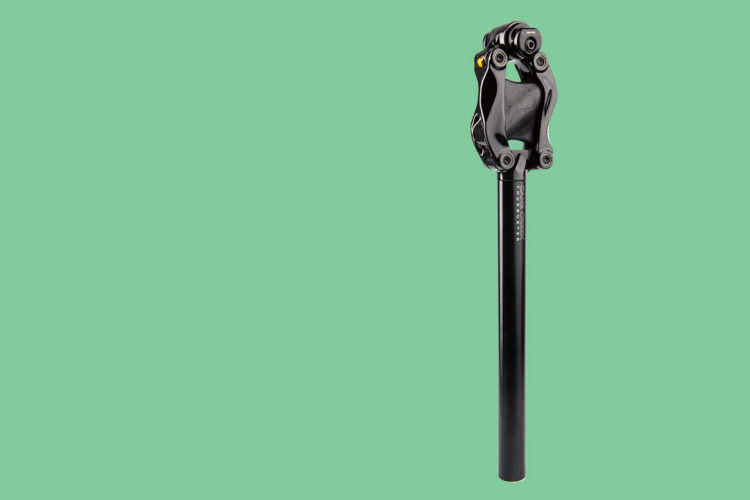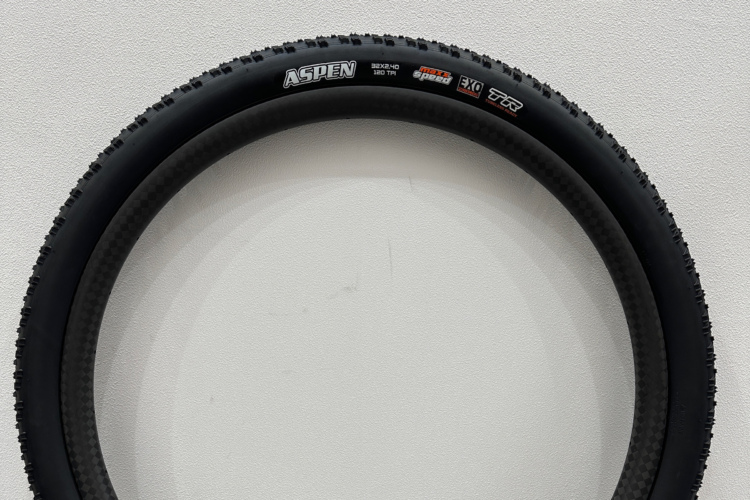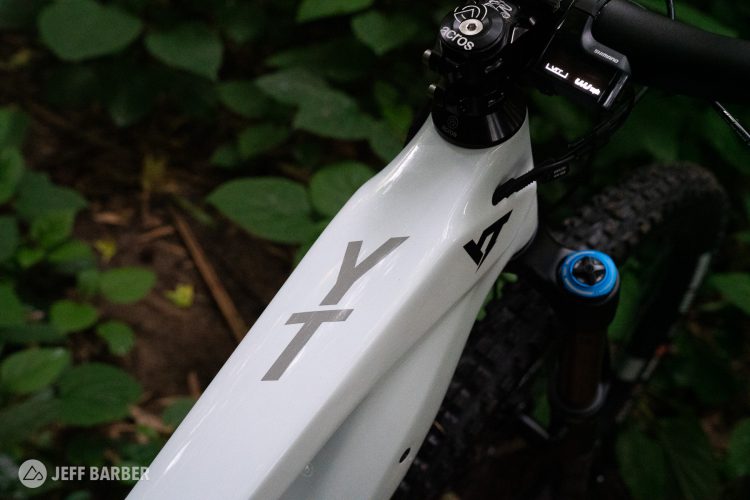Almost exactly a year ago Cane Creek introduced the Helm Works Series 130 mountain bike fork. With 130mm of travel in a lighter weight package than the standard Helm, the Works Series 130 promises to be an excellent choice for trail bike builds. I’ve been testing the fork on my own hardtail trail bike build for the past five months, and here’s what I’ve learned.
Features
Cane Creek specs 35mm stanchions on the Helm Works fork. This is the same stanchion size as the RockShox Pike (which offers up to 160mm of travel), and slightly larger than the Fox 34 series. For just a 130mm-travel fork, this is a beefy stanchion diameter designed to provide plenty of torsional stiffness.

A 30mm wrench loosens the cap on the volume adjustment assembly. 
This wingnut sets the position of the air volume piston.
With high and low speed compression and rebound controls, the Helm Works fork is incredibly tunable. Air volume is easily adjustable with just a 30mm wrench and the fork’s travel is adjustable down to 120mm with a spacer.
Like the Helm, the Helm Works features independent positive and negative air springs. The unique D-Loc axle adds even more stiffness to the package. There’s no quick release lever on the axle which no doubt saves weight, but does add a bit of hassle if you’re removing the front wheel often.

Officially Cane Creek says 29er tires up to 2.5″ wide and 27.5+ tires up to 3″ wide will fit; unofficially I was able to fit 2.6″ 29er tires in mine, though admittedly it is a tight squeeze. There is not a 27.5″ version of the Works Series 130 and the 29er fork is only offered with a 44mm offset. The fork requires 180mm rotors at a minimum.
All told, the Helm Works fork weighs 1999g, about 100g less than the standard Helm.
Setup

Initial setup is simple. Cane Creek recommends airing the fork to half your imperial weight in psi. For example, I weigh about 170 pounds with all my riding gear which translates to 85 psi. Once the positive air chamber is charged, press the negative air chamber equalizing button at the bottom of the left stanchion. Check that the sag is approximately 15-25% with the compression fully open and use this as a starting point.

Rebound is simple to adjust. 
The high and low speed compression knobs feature detents for repeatable settings.
Since I’m generally pretty light on the front end of the bike I settled on slightly less pressure (75psi) than the recommended amount. I also increased the air volume for a more supple feel throughout the stroke. For riders who prefer to smash hard, more pressure and reduced volume will be the way to go. Fortunately Cane Creek makes it easy — just move the wing nut inside the air valve assembly, no volume spacers required.
It’s clear the Helm Works is a premium fork made from quality materials and everything is machined to high tolerances. Every cap and bolt screws on smoothly, and the interfaces are all either tool- or finger-friendly.
On the trail

One of the first things I noticed on the trail is the smooth responsiveness of the Cane Creek Helm Works Series 130 fork. There’s little noticeable stiction as the fork moves from a static position into its travel. Even after riding hundreds of miles of dusty and muddy trails, it feels supple and reactive to minor bumps in the trail. The precision machining of the stanchions and lowers, along with the tight seals, no doubt has kept the fork performing well over months of real world testing.

The Helm Works fork features a climb mode that can be engaged via the high speed compression knob on top of the fork. This effectively closes off the compression circuit but compared to other forks with a similar feature, it doesn’t feel even close to fully “locked out.” In my experience that’s been a good thing, keeping the fork responsive but not bouncy on technical climbs. It’s also saved me a few times when I’ve forgotten to open the fork back up on a descent. On the flip side, it’s not the most efficient climbing fork I’ve tested.
Looking at the specs it’s no surprise that the Helm Works fork feels incredibly sturdy no matter what direction it’s pushed. This is particularly noticeable with weight over the bars on a steep, technical descent, coming into a corner, or climbing awkward punchy sections. The fork functions as a solid unit so every input at the bars travels directly to the wheels.

Although the Helm Works weighs less than the standard Helm, it’s certainly not the lightest among similarly-priced forks with the same amount of travel. Cane Creek has prioritized lateral stiffness at the expense of a lighter weight trail fork and the heft is noticeable on the front end. So while it takes a bit more effort to get the front wheel off the ground, the fork stays planted and tracks the ground with precision. If there’s a spectrum running from XC to trail to enduro, the Helm Works — despite its relatively short travel — leans closer toward the enduro than the XC side.
Rather than shrinking the stanchions or shaving grams off the uppers Cane Creek seems to have found other places to save a little weight. For example, instead of a cam lever on the thru axle, the Helm Works features a slimmed down, bolt-on axle that is tightened using a 5mm allen wrench. This definitely saves weight, gives the fork a cleaner look, and eliminates potential problems with a cam lever, but it does so at the cost of convenience.
I haven’t had any issues running a 2.6″ Teravail Honcho tire up front. There certainly isn’t enough room to run a tire this big with a fender, but mud and debris clear the arch just fine.
Bottom line

The Cane Creek Helm Works Series 130 ($899 MSRP) delivers a brawny level of performance that shorter travel trail bikes don’t often receive. For that reason, it’s a great choice for folks who like to smash technical trails or riders who want to build up a bikepacking rig for slashing singletrack. And yet, it’s adjustable enough that softer touch riders can get the smooth and responsive feel they want.
⭐️ Find the Cane Creek Helm fork at JensonUSA, Wiggle, and other retailers.
Thank to Cane Creek for providing the Helm Works Series 130 fork for testing and review.
















1 Comments
Apr 8, 2020